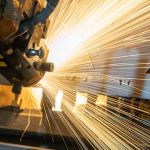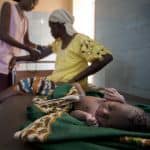The Challenges of Going Local: A Medical Device Innovator Faces the Reality of Manufacturing in Rural Africa
When Noor Medical engineer Enock Musasizi was just a child, he saw first-hand how difficult it could be for providers to sterilize medical equipment in his village in Uganda. After receiving an injection he was told to take the syringe back home, boil it and bring it back to the clinic the next day to receive the second dose.
Though he didn’t know it at the time, Musasizi realized later in life that it is not possible to achieve proper sterilization by boiling water in an open space, because you cannot exceed temperatures of 100 degrees Celsius – which is not hot enough to kill all microorganisms. That meant the syringes they were using in his childhood – and that many still use today – were not actually sterilized, because they couldn’t bring water to the right temperatures and pressures.
A Solar Sterilization Solution
After studying mechanical engineering at university, Musasizi started thinking about how this problem could be tackled. He quickly realized that an electrical solution would only work in the Ugandan capital of Kampala, where access to electricity is not a problem. In the regions surrounding Kampala, however, the sterilization of medical equipment was far more difficult. “Deep in the village where I grew up … we could actually experience a week without electricity,” he says. The implications were clear: A workable solution would have to be solar.
Musasizi designed a solar-thermal hybrid autoclave prototype, based on his childhood experiences experimenting with concave lenses to capture the sun’s rays and start small fires with dry leaves. He combined this experiential knowledge with a bit of physics to capture the right waves and concentrate them on a focus point to generate heat and steam.
After Musasizi posted a video of his device on the internet, a chance online discussion brought him into contact with Noor Medical. The team, based in Freiburg, Germany, was also working to tackle the medical instrument sterilization issue using solar thermal energy. Over the next few months, Musasizi worked with Noor Medical to conduct additional tests and modeling, both in Germany and in Uganda. Musasizi brought his extensive local knowledge and the Noor Medical team brought in additional resources to validate market needs and iterate through designs. The prototypes generated sufficient temperature and pressure for sterilization using solar energy – but the approach did have its downsides: Namely, it became ineffective on cloudy days.
Noor Medical is currently addressing this challenge by designing a solar photovoltaic and battery hybrid model. Since bringing Musasizi onto the team, the company has worked to improve the prototype, conduct biological testing and develop deeper ties to the local communities surrounding Kampala. Connecting to the local realities is absolutely critical when developing a context-sensitive engineering solution. And constructing our prototypes in these Ugandan communities was also a necessary business decision: Iterating through designs in Germany was not initially cost-feasible for us. So we figured that sourcing everything locally was the best bet.
But we soon learned that this is easier said than done.
The Challenges of Local Production
For starters, sourcing components requiring high manufacturing precision, such as pressure and temperature gauges, proved to be difficult. Even when we could find a supplier in Kampala, we were astonished to find that the cost was often 50% higher than what could be sourced from the United States or Europe. Still we carried on, sourcing nearly 95% of our components from the local region. The next challenge? Figuring out how we might economically scale production of our prototypes for pilot testing purposes.
Most often, bringing up the word “scale” with potential investors, especially in the manufacturing space, yields answers that include the words “China” and “India.” True, we probably could locate manufacturers in those countries that could supply greater volumes at lower cost than what would be available in East Africa. But cost and volume weren’t the only variables of concern: One of our founding ambitions was to make it easy to repair our hybrid autoclave with local components, and one of the ways to ensure this is to manufacture locally. Local production has the added benefit of building goodwill with important area stakeholders. Plus, as our young team began to find out, manufacturing in Uganda would likely become more competitive as the trade environment improved.
One aspect of this is the recently signed African Continental Free Trade Agreement, which will create a tariff-free continent – boosting local businesses and revving up industrialization. Prior to this agreement, a patchwork of trade regulations and tariffs worked to make intra-Africa commerce costly and cumbersome, so manufacturing in Uganda with the goal of exporting to neighboring countries would have been a less-than-ideal solution. Now, local manufacturing represents a clear advantage, since shipping our units from Germany to Uganda would subject them to tariffs upwards of 25%, alongside the vastly higher manufacturing costs in Germany.
The Value of Partnerships
However, as we moved forward with our plans for local production, we came to realize that we couldn’t do it alone. Our questions involving manufacturing gradually developed from, “How can we do this locally ourselves?” to “What would our ideal partner look like to do this effectively?” The evolution of these questions was tied with our growing understanding of the difficulties of building a product in-house. For one thing, sinking resources into understanding local supply lines and the availability of materials was beyond the scope of what we could accomplish. Sure, this gives you greater control over what you produce, but our inexperience in these matters threatened to derail our true focus – to aid in the design and implementation of novel sterilization equipment at rural health facilities.
Fortunately, we were beginning to build a superb network of medical professionals and important surgical health stakeholders. Linking their knowledge with the team we had on the ground allowed us to identify potential partners for the production of an autoclave device designed for the local health care context.
By the summer of 2018 we had decidedly moved away from the goal of manufacturing the product ourselves in Uganda. Our energy was better directed at working with a few of our research and development partners in Germany to improve the efficiency of our autoclave unit. Around that time we were first introduced to Bodawerk, an innovative Uganda-based engineering and innovations company with a focus on developing e-mobility solutions for Uganda and the East African market. Co-founded by a fellow German, Bodawerk had a startup mentality that we felt would be the perfect fit for Noor Medical as we iterated through new designs and performed technical tests.
Bodawerk’s workshop enables innovative ideas, technical designs and prototypes to be developed and created by Ugandans: It provided the perfect launch pad for Noor Medical as we tested our device in the field. Since our partnership began, Bodawerk has rapidly expanded, and it now provides the scale necessary for Noor Medical for the foreseeable future.
As the industrial base of the African continent continues to develop, there will be an ever greater number of options for SMEs to expand their enterprises without relying on manufacturing partners overseas. This presents powerful opportunities for companies to not only provide the local populace with products that serve their needs, but also to help support local economies in other ways. Noor Medical has been fortunate to find a value-aligned manufacturing partner in our local market, and we look forward to continuing our mission of making safe surgery a reality for rural health care contexts.
In the last few months we have conducted biological testing in cooperation with the Institute for Infection Prevention and Hospital Epidemiology in Freiburg, Germany, and have passed critical thresholds for medical instrument sterilization. As our next product iteration takes shape in Germany, we are already planning our next rounds of testing in the field in Uganda.
If you or someone you know works at a rural health care facility in Uganda or neighboring countries, please contact us to learn more about our user-interface testing program at info@noor-med.com. To learn more about Noor Medical please visit our website or follow us on Facebook, LinkedIn and Twitter.
Andrew Bonneau is Chief Operating Officer (COO) at Noor Medical.
Photo: Noor Medical CFO Federico Castillejo and Enock Musasizi, with an early version of Noor’s solar thermal autoclave.
- Categories
- Health Care, Social Enterprise, Technology



